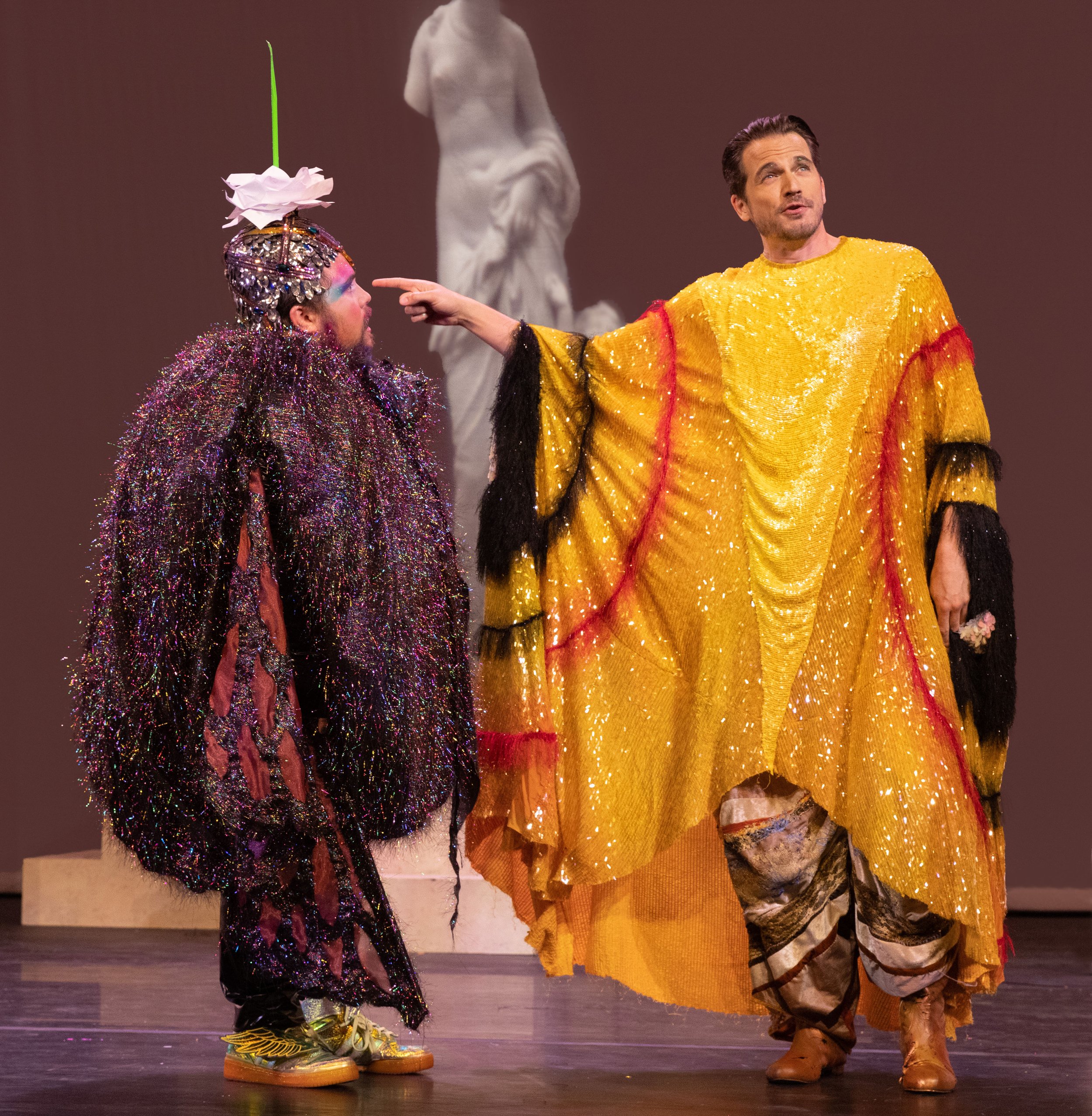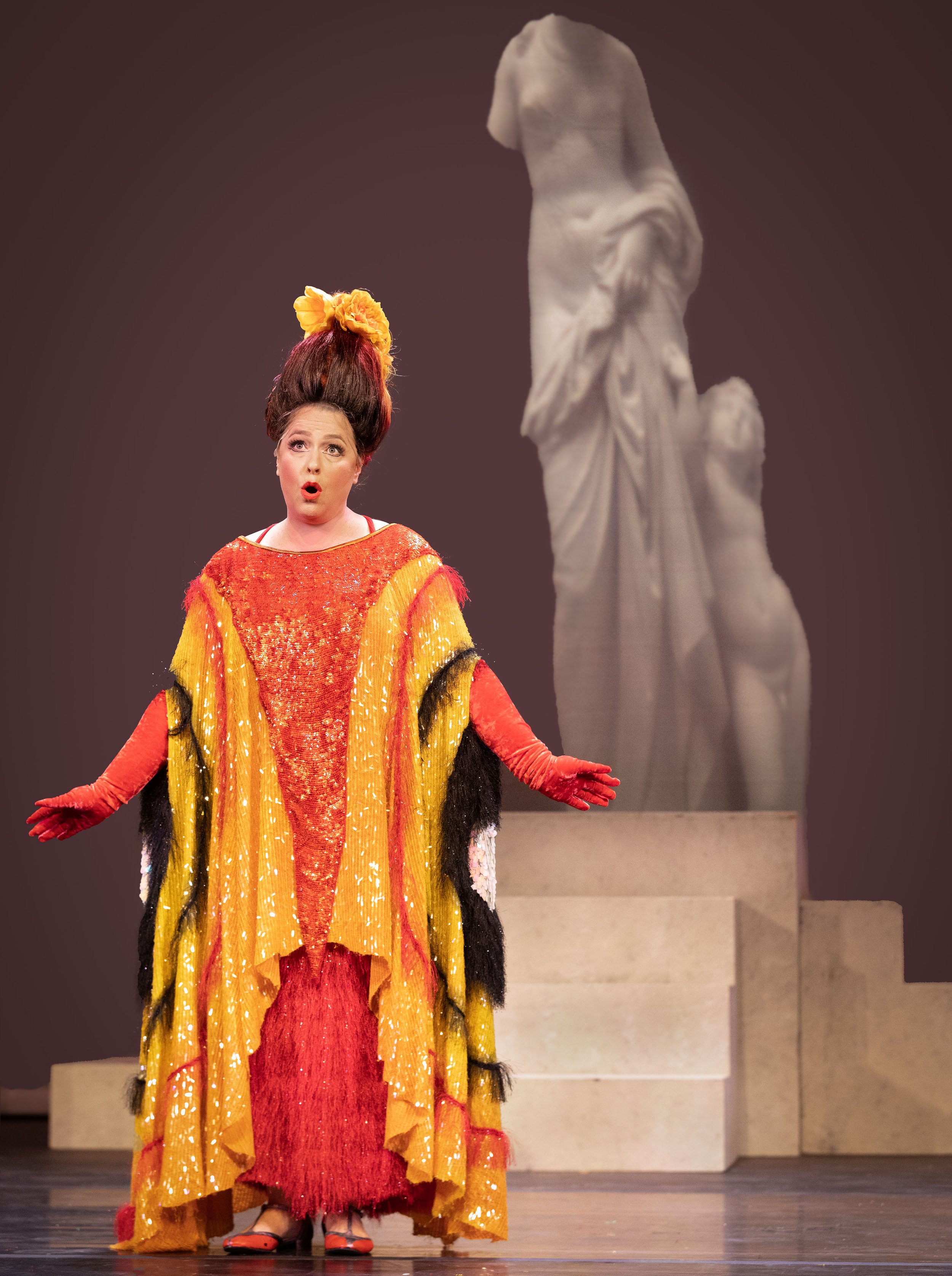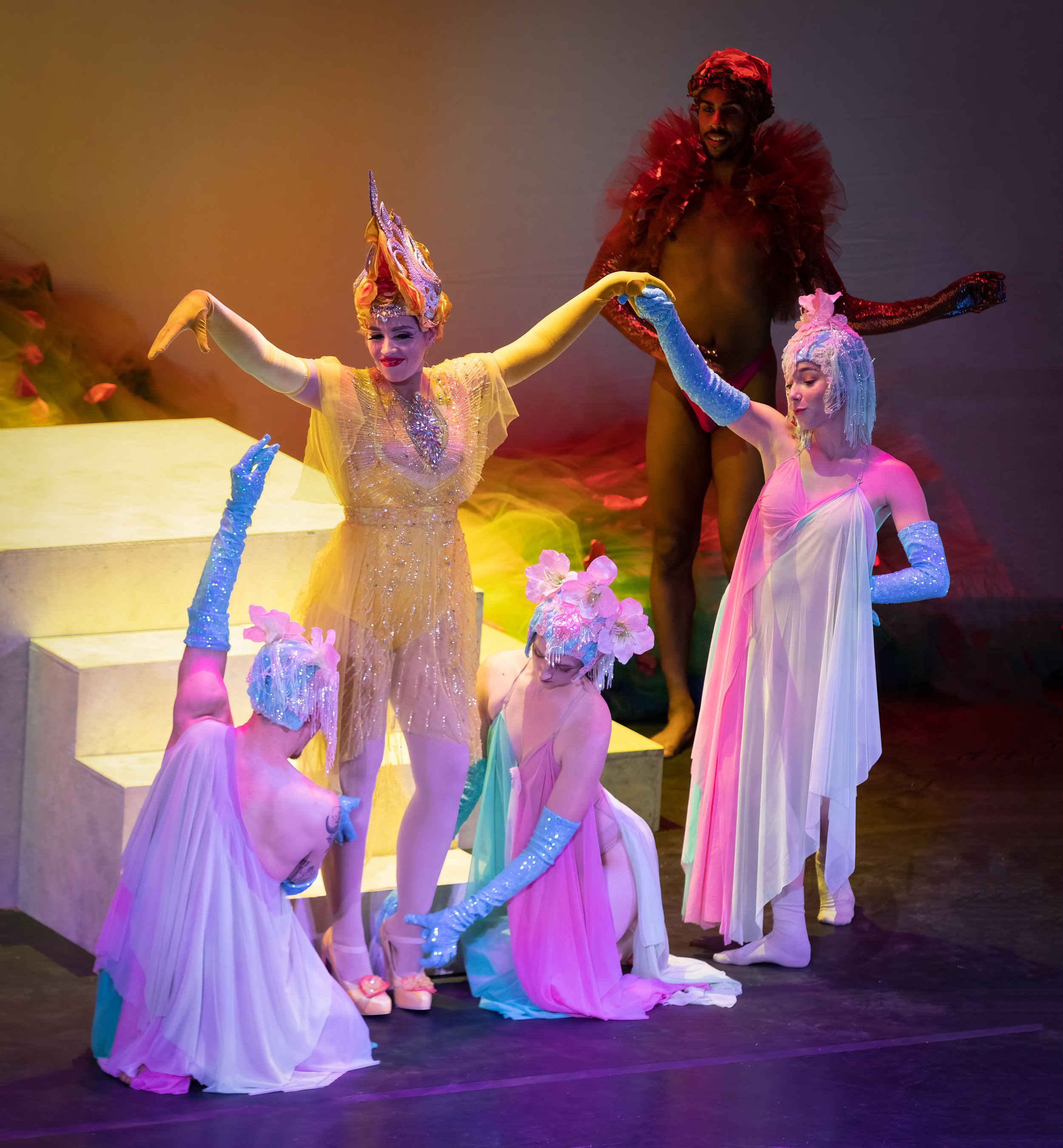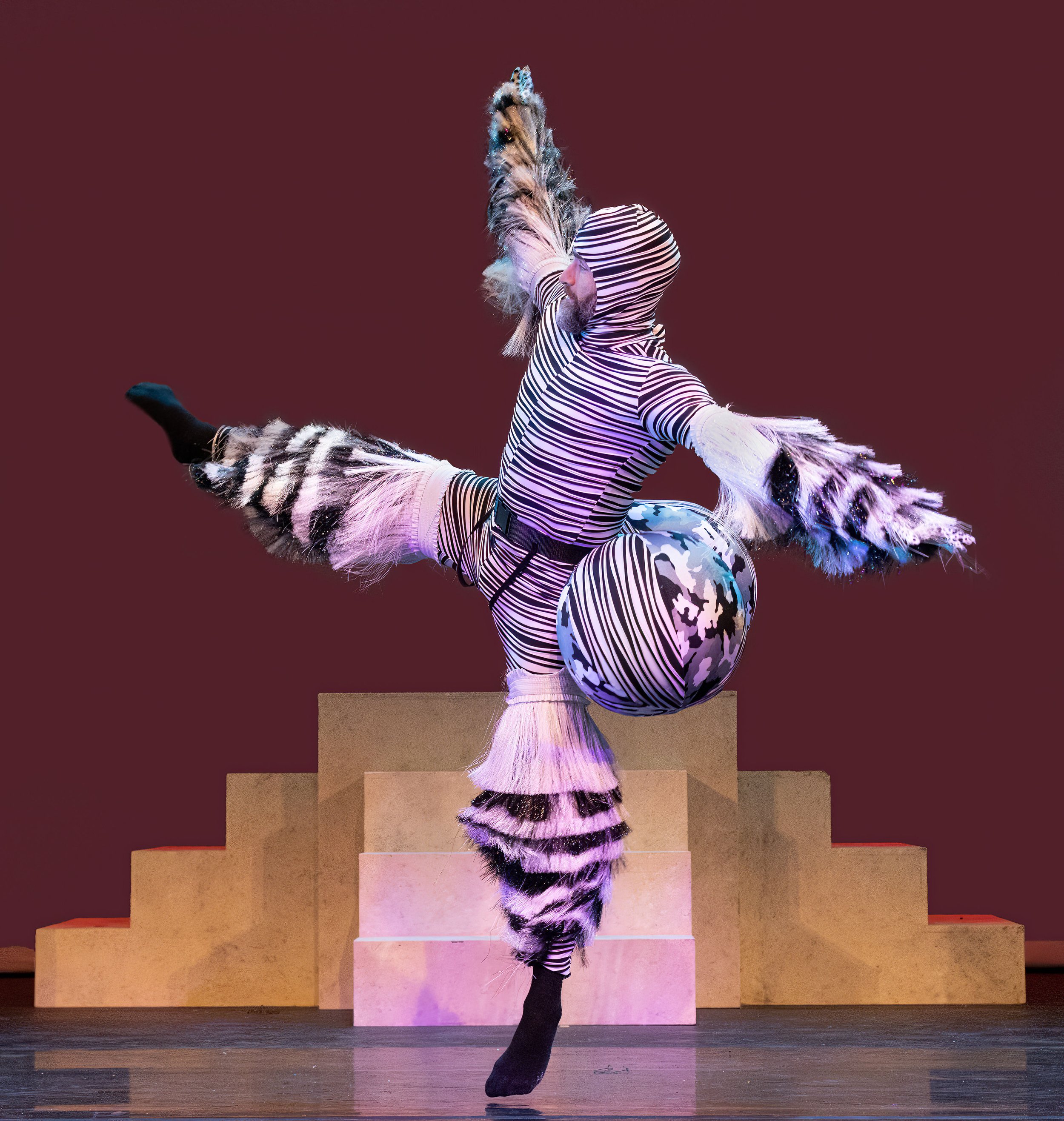The timing for these performances was all wrong. On Tuesday Night, Opera Lafayette blew the roof off the Kennedy Center and continued its recent trend towards bringing yesterday’s French music to today with authenticity but in ways that modern audiences can more fully appreciate and enjoy. The operas and music were good; the singers and dancers were great; and Machine Dazzles’s costumes must be seen to be believed. These two performances together should either have been held on New Year’s Eve in the Kennedy Center or as part of the Mardi Gras celebration in New Orleans, and soprano Gwendoline Blondeel as La Folie would have been declared queen of the ball. For Io in particular, Opera Lafayette put the spectacular in opera’s spectacle. As they say in New Orleans: Laissez les bons temps rouler!
La Folie (Gwendoline Blondeel) in Opera Lafayette’s Io surrounded by Graces and Pleasures (Séan Curran dancers). Photo by Jennifer Packard Photography; courtesy of Opera Lafayette.
Composer Pierre de La Garde’s and librettist Pierre Laujon’s Léandre et Héro (1750) and composer Jean-Phillipe Rameau’s Io (2023) were expected to provide a pleasant evening of authentic 18th century French music, singing, and dancing performed beautifully by polished performers with dash added by the creative efforts in costuming by Machine Dazzle. It was so much more. The costumes dazzled alright, but so did the staging, the choreography, and the performances. Founder and Artistic Director Ryan Brown remains true to OL’s mission but refuses to let this company rest on its laurels. I am literally still decompressing from Tuesday night’s experience.
Cast photo from Léandre et Héro with Maxime Melnik as Léandre and Emmanuelle de Negri as Héro in center, surrounded by Séan Curran Company dancers in modern costumes, Triton costumes and dancers in period shepherd and shepherdess costumes of The New York Baroque Dance Company on either side, and Douglas Williams as Neptune on the pedestal in the background. Photo by Jennifer Packard Photography; courtesy of Opera Lafayette.
I covered much of the background for these two works in a preview report but let me touch again on a few important points:
1. Léandre et Héro and Io are actes de ballet, which are single act versions of French operas-ballets, a mix of opera and dance with an ending divertissement of primarily dance intended to be “joyous, festive, and conclusive”.
2. Léandre et Héro was presumed lost, but a copy showed up at auction in 2021; Opera Lafayette obtained exclusive production rights from Bibliothéque Nationale de France for one year to produce a modern premiere, not seen for about 270 years. Because this acte de ballet, being last in a trilogy, lacked an overture, and for this performance, OL added an overture from similarly themed Clerambault’s Léandre et Héro and de La Garde’s La Toilette de Venus.
Douglas Williams as Neptune, god of the sea, with Séan Curran Company dancers in the foreground. Photo by Jennifer Packard Photography; courtesy of Opera Lafayette.
3. Io was thought to be unfinished, but scholars with Rameau’s Opera Omnia led by Sylvie Bouissou recently surmised that the missing parts had been removed for use in another opera, Rameau’s Platée, and they were able to reconstruct Io. OL’s is a first-ever production of this 280-year-old work.
4. Performances of these two actes de ballets was the final segment of OL’s 2022-2023 DC season whose theme has been the life and times of Madame Pompadour. She, King Louis XV’s chief mistress, sang the role of Héro at Versailles; she was also a major supporter of Rameau and other composers, and had a substantial influence on the development of French music in the mid-18th century.
Séan Curran dancers in modern costumes and Triton attire in the Baroque style, dance before Neptune (Douglas Williams), Léandre (Maxime Melnik), and Héro (Emmanuelle de Negri). Photo by Jennifer Packard Photography; courtesy of Opera Lafayette.
5. All three productions of Opera Lafayette’s 2022-2023 season now move to be performed next week in a festival format in NYC. This expert combination of history, education, and performance art, all solidly researched by experts, is typical of Opera Lafayette and is what makes it extraordinary.
Léandre et Héro tells the dramatic story of two mythical characters, Léandre who swam every night across a sea to visit his forbidden love, Héro, until he drowns in a storm, and when Héro learns of this, she jumps into the sea and drowns. Neptune brings them back to life, making them immortal so their love can survive forever. Io is a comedy in which Jupiter and Apollo, in disguise, compete for the affection of the mortal Io. Jupiter wins and creates a storm revealing his godly nature. Apollo leaves and La Folie (Folly) appears, leading Jupiter’s charge for everyone to partake in fun and games, pleasures, and graces. The ending divertissements for each work were about one-third of the acts – a substantial dance involvement.
left photo: Patrick Kilbride as Mercury and Douglas Williams as Jupiter. right photo: Emmanuelle de Negri as Io. Photos by Jennifer Packard Photography; courtesy of Opera Lafayette.
Stage direction and French libretto translation (shown on an above screen) for both works was done by Nick Olcott. The same simple set was used by both actes de ballet, white columns in a V-shape pointing to a pedestal with a screen projection of the goddess of love appearing above the pedestal and screen projections of clouds behind the columns. Credit to Lighting Designer Christopher Brusberg for lighting changes that enhanced the scenes. For the first work, in front of the columns was the sea composed of six dancers from the Séan Curran Dance, wearing modern blue tights. The first surprise of the night, both funny and delightful, was the manner by which Léandre swam through the sea to meet his love. The stormy sea in which Léandre died and then Héro committed suicide required some nifty choreography by Séan Curran. Standing on sidelines in baroque costumes were six dancers representing inhabitants of Sestos and Tritons from the New York Baroque Dance Company; the baroque dance moves were choreographed by Catherine Turocy.
left photo: Maxime Melnik as Apollo. right photo: Gwendoline Blondeel as La Folie being attended by Séan Curran Company dancers as three Graces. Photos by Jennifer Packard Photography; courtesy of Opera Lafayette.
The excellent cast of singers for Léandre et Héro included tenor Maxime Melnik as Léandre, making his U.S. debut, the pure-voiced soprano Emmanuelle de Negri as Héro, who starred in OL’s the Salons of Versaille, and bass-baritone Douglas Williams as Neptune. All sang beautifully and effectively portrayed their roles. Ms. de Negri was especially captivating in this role, which fit her singing style perfectly, allowing the beauty in her voice to shimmer and shine. The de La Garde’s music, well-played by the Opera Lafayette Orchestra was led by Avi Stein as both conductor and harpsichordist. The pleasing music accompanying the vocals was mostly by harpsichord. The soloists were joined impressively by a 15-member chorus who sang off-stage, then from rows in the audience, finally joining on stage in costume as characters of Sestos, Sailors, and Divinités de la Mer. The music for the divertissement was livelier and fuller, played by the complete 23-member ensemble, a mixture of strings and woodwinds. The visual appeal of the dancing greatly elevated the appeal of Léandre et Héro, making it fun; may the lovers live forever. However, as inventive and enjoyable as it was, this performance did not prepare me for what was to come. Opera Lafayette kicked it up a couple of notches with Io.
Séan Curran Company dancers in left photo as Fun & Games and in the right photo as Pleasures. Photos by Jennifer Packard Photography; courtesy of Opera Lafayette.
For Io, the three singers switched roles and continued their excellent vocals; and, importantly, some new ones were added; dancers were from Séan Curran Company with choreography by Séan Curran. Bass-baritone Williams became Jupiter and tenor Melnik became Apollo, both trying to win the heart of Io, played by soprano de Negri, played in campy style. Mr. William’s singing as Jupiter commanded the stage even more effectively than it did as Neptune, and Mr. Melnik was an appealing loser in the race for love. The reliably effective tenor Patrick Kilbride joined as Mercury in the early going, assisting Jupiter in his plot. The early part of this comedy was Marx brothers-like with lots of banter and characters running about in and off stage trying to see and not be seen; Director Olcott enhanced the pace and fun with a snappy, slang filled libretto translation. Finally, Jupiter called the question and created a swirling storm, followed by a celebration of Graces, Fun and Games, and Pleasures. Machine Dazzle’s costumes to this point in Io had been striking, with great attention to detail and meaning, i.e., Apollo was dressed in a fishnet with fish attached signifying his failed attempt to woo Io, caught in his own net. In an essay in OL’s program booklet, Melissa Hyde and Mark Ledbury point out that Machine Dazzle’s exuberant, boundary defying costumes fit the rebellious Rococco style and culture of the mid-18th century France arts scene, the period of Io’s composition. The attached photos can serve as an introduction to the costumes’ color and design, but you need to be present in person to fully experience the textures and vibrancy of the pieces.
Then, the explosions came, first in the form of the storm, where the characters were blown around and were joined by costumed Séan Curran dancers, three twirling about holding costumed whirlwinds overhead (this must have taken a lot of practice). Then as the storm recedes, three dancers appear as Graces in beautiful, alluring costumes; two male dancers appear in purple, erotic outfits as Pleasures; and one dancer in a black and white striped costume with large balls attached appeared as Fun and Games. Even this did not prepare me for what was to come. Suddenly the action slowed as someone in an enormous yellow and pastel costume was assisted onto the stage. The lights came up and soprano Gwendoline Blondeel as La Folie was in place on the pedestal bedecked in a huge, stunning, ostentatious, bright yellow costume. Apollo had departed, and she has stolen his lyre to lead the merriment, proving life is crazy by turning things topsy-turvy, making sad songs fun and fun songs sad.
Finale photo from Io featuring costumed Séan Curran Company dancers. Photo by Jennifer Packard Photography; courtesy of Opera Lafayette.
La Folie’s entrance was eye-opening itself, but if you saw Ms. Blondeel singing “Stabat Mater” in a reverent church girl performance in Opera Lafayette’s Pergolesi! earlier this year, you’d find her performance as La Folie a rather shocking transformation. The first few minutes of her center piece solo, I felt like I was in Las Vegas and Beyoncé had just come on stage. She soon unbuckled her outsized costume and gave a leggy showgirl performance from then on. Wow, what a dynamic singing performance; it was beautiful operatic singing, but it was also showtime, a strong contender for my favorite performance of the year! The Opera Lafayette Chorus, also costumed in Machine Dazzle’s shimmering duds appeared on stage to join in the fun. Delightful fun, singing and dancing filled out the performance. Special kudos to Ms. Blondeel for her show-stopping performance in what was quite a show.
Conductor Avi Stein also led the Opera Lafayette Orchestra and Chorus in Io. The musical performances were excellent. I enjoyed Rameau’s music which seemed fuller and more complex than de La Garde’s, but honestly, the visuals in Io were so engaging that I could not focus on the music or playing; perhaps the most appropriate comment might be that the music and the chorus participation fit beautifully with an overall outstanding program. To have been less would have been distracting.
Opera Lafayette, you have outdone yourself! I cannot imagine what next season drawn from The Era of Madame de Maintenon will bring, but I do not intend to miss it.
The Fan Experience: Léandre et Héro and Io were scheduled for performances on May 2 and 3 in the Terrace Theater of the Kennedy Center and on May 9 at the El Museo del Barrio Theater in NYC; the entire Festival program for NYC can be found at this link. The actes de ballets were sung in French with supertitles in English. The performances were scheduled for two hours, including a 20 minute intermission but ran closer to 2.5 hours total.
An informative pre-opera discussion that took place one hour before showtime included Opera Lafayette Artistic Director Ryan Brown, Mathais Auclair of the Bibliothéque Nationale de France, music historian and Rameau expert Sylvie Bouissou, and music historian Rebecca Harris-Warrick.
These experts also contributed to an extensive program book that includes essays by these authors and others.











